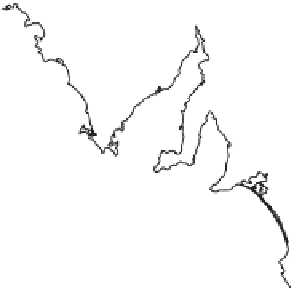Geology Reference
In-Depth Information
Table 3.
Percentage of epiphyte taxa on different seagrass species, and their various components. • = total %,
N
= number
of samples.
Coralline
algae
Seagrass species
Bryozoans
Spirorbids
Serpulids
Foraminifera
Ostracods
Bivalves
Other
•
N
A. antarctica
blade
38.2
24.3
14.7
0.1
15.9
0.03
0.22
0.00
93.5
425
A. antarctica
stem
66.0
27.9
0.5
0.4
2.7
0.03
0.01
0.00
97.6
54
A. griffi thii
blade
67.8
9.8
7.6
0.1
4.8
0.00
0.00
0.00
90.5
357
A. griffi thii
stem
64.5
33.6
0.1
0.1
0.1
0.00
0.00
0.00
98.4
53
P. angustifolia
63.0
15.9
5.3
0.2
9.3
0.00
0.52
0.00
94.1
120
P. australis
60.4
12.0
6.4
0.1
16.7
0.00
0.01
0.00
95.6
179
P. sinuosa
50.4
8.5
14.1
0.2
24.1
0.00
0.14
0.04
97.4
334
fenestrate
Iodictyum
sp. (21% of all carbonate
generated from bryozoan epiphytes), followed
by the erect arborescent
Celleporaria
sp. (8%),
encrusting robust sheet
Thairopora cincta
, (6.9%)
and
Mychopletra pocula
(6.3%). The most com-
mon species
Heterooecium
, however, contributes
only 1.2% of the carbonate. The most important
carbonate-producing bryozoans per unit area
are
Iodictyum
(14.8%),
Thairopora
(13.6%) and
Mychopletra pocula
(10.1%). The most important
producing morphotype is 'erect fenestrate', which
produces an average of 26.7 g m
2
or 44.1 g kg
1
of
seagrass, but this form is relatively uncommon
amongst the epiphytic bryozoans.
1
Calcareous epiphytes
N
2
3
Coralline
algae
Bryozoans
Benthic
foraminifera
Spirorbids
Bivalves
0
100
kilometres
200
Shallow
Deep
Overall average
Fig. 9.
A map showing the relative proportions of calcare-
ous epiphytes on all grasses at each site.
Benthic foraminifera
These protists (Fig. 11) occur at all sites and on
all seagrass species and generated 0.1 to 33.6% of
all epiphytic carbonate (Table 3). They are pres-
ent on 939 (~2/3) of the blades and stems ana-
lysed. They comprise 30 species from 18 genera,
mostly 'clinging' types followed by 'adhesive' and
'encrusting' types. The only encrusting form is
Nubecularia
sp. All of these tests are composed of
calcite with varying Mg contents.
The maximum amount of carbonate is 27.6 g m
2
or 282 g kg
2
of seagrass (average 1 g m
2
or 4 g kg
1
).
About 45% is from
Discorbis dimidiatus
, and 33%
from
Nubecularia
sp.
Discorbis dimidiatus
grows
on all seagrass species and occurs at every site.
The second most widely distributed genera is
Elphidium
. The total amount of carbonate pro-
duction does not have any particular relationship
with specifi c geographical region nor any correla-
tion with temperature, salinity and depth.
The most frequently occurring, in terms of
their distribution on different seagrass species,
are
D. dimidiatus
,
N. lucifuga
,
Nubecularia
sp.
and
Elphidium
sp., which are present on all sea-
grasses, whereas
Spioloculina antillaum
grows
decreased light, lower temperatures, and shorter
day lengths during that time of year.
Bryozoans
Bryozoans (Fig. 10) occur at all sites and on all
seagrasses (Tables 2-4). They produce 8.5-33.6%
of all epiphytic carbonate and are present on
916 (~2/3) of the blades and stems analysed.
The biota comprises 61 species from 47 gen-
era. The most frequently occurring form is the
cheilostome
Heterooecium
sp. (19 of 23 sites).
The next is another cheilostome
Thairopora
sp.,
closely followed by the cyclostomes
Diaperocecia
australis
,
Crisia acropora
,
Disporella pristis
and
Favospira
sp. All of the foregoing bryozoans are
composed of Mg calcite (Bone & James, 1993).
The most common morphotype (cf. Bone &
James, 1993) is 'encrusting delicate sheet' whereas
the most common erect bryozoan is the 'delicate
branching type' and then 'articulated zooidal'
type. When bryozoan carbonate is averaged from
all sites, the most important species is the erect
























































































